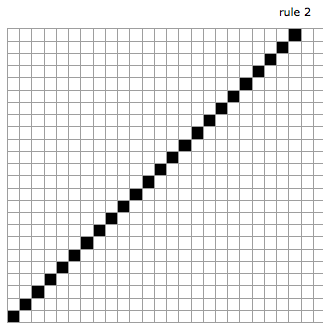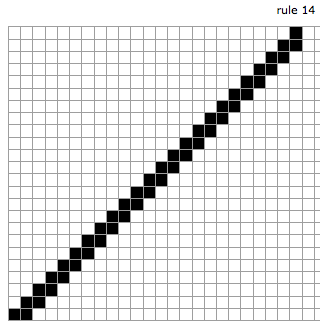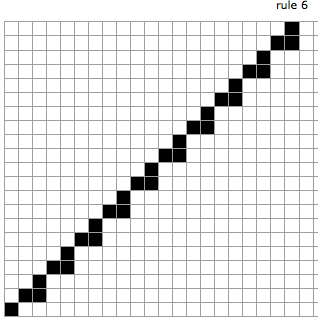Patterns to Ponder
![[Home]](../NavIcons/Home.GIF)
![[Up]](../NavIcons/Up.GIF)
![[Help]](../NavIcons/Help.GIF)
Here are some things to figure out about elementary cellular automata (ECA):
- No even-numbered ECA has a black background. Why is that?
- No ECA with a rule less than 128 has a black background. Why is that?
- Only ECAs with a rule less than 128 have (horizontally) striped backgrounds. Why is that?
- Diagonals don't seem very interesting, but actually there are some patterns to ponder: A "simple" diagonal consists of one cell that moves left or right as time goes on.
 There are 16 positive-slope simple diagonals (cell moves left - see rule 2 at right), and 16 negative-slope simple diagonals (cell moves right). Why is that?
There are 16 positive-slope simple diagonals (cell moves left - see rule 2 at right), and 16 negative-slope simple diagonals (cell moves right). Why is that?- The first positive-slope simple diagonal is the rule 2 ECA. The next one is rule 10 - a difference of 8. The next one is rule 34 - a difference of 24. The next one is rule 42, a difference of 8. The next one is rule 66, a difference of 24. This pattern continues, and a similar pattern, with differences in rule numbers of 8, 24, 8, 24, ... exists for negative-sloped simple diagonals - why?
- If rule n is a positive-slope simple diagonal, then rule n + 14 is a negative-sloped simple diagonal. Why?
 Double diagonals consist of 2 adjacent cells (after the initial generation) that move to the left or right. There are just 4 left-moving doubles and 4 right-moving doubles. Why 4?
Double diagonals consist of 2 adjacent cells (after the initial generation) that move to the left or right. There are just 4 left-moving doubles and 4 right-moving doubles. Why 4?
 Triple diagonals alternate one cell/two cells/one cell from generation to generation as they move left or right. (See rule 6 at right.) There are 4 leftward-moving and 4 rightward-moving ECA's. Why 4?
Triple diagonals alternate one cell/two cells/one cell from generation to generation as they move left or right. (See rule 6 at right.) There are 4 leftward-moving and 4 rightward-moving ECA's. Why 4?- There are no 4-cell diagonals. Why?
There are LOTS of patterns - what can you find?
![[Home]](../NavIcons/Home.GIF)
![[Up]](../NavIcons/Up.GIF)
![[Help]](../NavIcons/Help.GIF)
last update May 6, 2010 by JL Stanbrough
 There are 16 positive-slope simple diagonals (cell moves left - see rule 2 at right), and 16 negative-slope simple diagonals (cell moves right). Why is that?
There are 16 positive-slope simple diagonals (cell moves left - see rule 2 at right), and 16 negative-slope simple diagonals (cell moves right). Why is that? Double diagonals consist of 2 adjacent cells (after the initial generation) that move to the left or right. There are just 4 left-moving doubles and 4 right-moving doubles. Why 4?
Double diagonals consist of 2 adjacent cells (after the initial generation) that move to the left or right. There are just 4 left-moving doubles and 4 right-moving doubles. Why 4? Triple diagonals alternate one cell/two cells/one cell from generation to generation as they move left or right. (See rule 6 at right.) There are 4 leftward-moving and 4 rightward-moving ECA's. Why 4?
Triple diagonals alternate one cell/two cells/one cell from generation to generation as they move left or right. (See rule 6 at right.) There are 4 leftward-moving and 4 rightward-moving ECA's. Why 4?